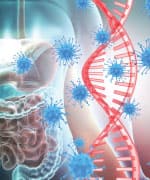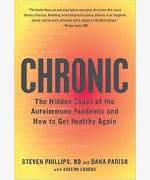Life Extension Magazine®

A pandemic of autoimmune and chronic illness is sweeping the globe, with 50 million people diagnosed in America alone.
In their new book, Dr. Steven Phillips and his former patient, SONY/ATV singer-songwriter Dana Parish, argue that the true cause of autoimmune disease is chronic, undiagnosed infections.
These infections—from Lyme to toxoplasmosis—are caused by a broad range of microbes and lack a simple fix.

In the absence of medical consensus, Dr. Phillips has created innovative treatment strategies to combat these infections. These include using a technique called “pulsing”—along with natural compounds like oil of oregano, grapefruit seed extract and probiotics.
Both Dr. Phillips and Parish nearly died of undiagnosed infections, and now they are on a mission to help prevent others from having the same experience.
In this interview with Life Extension®, Dr. Phillips and Parish delve deeper into this surprising connection—and Dr. Phillips shares some of his techniques for effectively treating these insidious infections.
—Laurie Mathena
LE: What is the connection between infections and autoimmune diseases?

Dr. Phillips: It’s striking to us that chronic autoimmune diseases are considered to be of unknown origin, yet so many have been linked in medical literature to infections, specifically Lyme and Bartonella.
When people receive a diagnosis of fibromyalgia, MS, lupus, rheumatoid arthritis, Sjogren’s, psoriatic arthritis, or another rheumatologic/inflammatory diagnosis, they are not getting an actual diagnosis, but rather a description of signs and symptoms that brings them no closer to an answer.
According to a survey of over 4,000 chronic Lyme patients, roughly 20% were initially misdiagnosed with one of the following serious neurologic diseases: MS, Parkinson’s, ALS, or Multiple Systems Atrophy.
Many doctors are not properly (and sometimes not at all!) evaluating these patients for the possibility of infections and it’s disgraceful.
LE: What exactly is Lyme?
Dr. Phillips: To say Lyme is a “tick-borne illness” overly simplifies the matter. The word “Lyme” has come to refer to a family of infections, referred to here as “Lyme+”— and the transmission of these germs is not just by ticks. [Some of these bacteria] can be transmitted by other bugs like fleas, lice, sand flies, spiders, and ants.
LE: What are some examples of conditions often linked to—and caused by—infections associated with Lyme+?
Dr. Phillips:
- Fibromyalgia
- Chronic fatigue syndrome
- Multiple sclerosis
- Rheumatoid arthritis
- Spondyloarthropathy—psoriatic arthritis, spondylitis
- Psoriasis
- Lupus
- Mixed connective tissue disease
- Migraines
- Inflammatory bowel disease, i.e., Crohn’s and ulcerative colitis
- Irritable Bowel Syndrome (IBS)
- Interstitial cystitis, bladder symptoms
- Psychiatric illness (e.g., depression, anxiety, OCD, bipolar disorder, and psychosis)
- Dilated cardiomyopathy
- Neurodegenerative diseases including ALS (Lou Gehrig’s disease), Alzheimer’s disease, Parkinson’s disease, and Lewy body disease
LE: That’s a shocking list. How could Lyme be mistaken for something like multiple sclerosis?
Dr. Phillips: Lyme can be clinically indistinguishable from multiple sclerosis, a fact that has been documented for decades.
Before the 1950s, spirochetes were visualized in the brains of MS patients and found from their spinal fluid. As documented in the Official Journal of the California Medical Association by a group of Stanford-based researchers, they named these organisms Spirochaeta myelophthora.
After that, a series of inoculation studies demonstrated that the tissue from the central nervous system of MS patients could be contagious. When lab animals were injected with this tissue, they became infected—their immune systems became inflamed and neurologic illness followed, sometimes resulting in paralysis and death.
In a 2001 study done in Norway, when researchers looked for infectious agents in the cerebrospinal fluid of MS patients, they found B. burgdorferi cysts in all of them, but not in healthy controls, with the exception of one, who had a prior history of Lyme.
LE: Is it true that rheumatoid arthritis was originally believed to be caused by an infection?

Dr. Phillips: Retroviruses, parvovirus B19, rubella, Epstein-Barr, and other herpes viruses have all been studied as potential causes of RA.
But the development of the steroid drug cortisone in the late 1940s, which had such an immediate suppressive effect, temporarily covering up painful inflammatory symptoms, led to a new assumption: that rheumatic disease was autoimmune and tended to run in families.
By the time the side effects and dependency created by the overuse of cortisone became evident and its promise of a “cure” was dispelled, a new medical paradigm and approach to treatment had become firmly established: treat the symptoms, stop looking for a cause, never find a cure.
There have been about a dozen randomized controlled trials comparing antibiotics to placebo, demonstrating benefits from antibiotics but not placebo in RA patients. And some of these studies used antibiotics that were devoid of anti-inflammatory effects.
What’s more, studies show benefits from antibiotics in RA patients, over and above the typical drugs prescribed, namely steroids and the chemotherapy drug methotrexate.
LE: How can invading germs flip the “switch” on the body’s immune system and cause what are commonly described as autoimmune disorders?
Dr. Phillips: The immune response produced against these infections can also attack normal cells because the invaders are tricky.
They’re coated with proteins that look very similar to our own, such as tissue found in our nervous system. When the immune system rallies to attack the bacteria, it can mistakenly attack nerve tissue as well, causing secondary autoimmunity.
LE: Standard, short-term antibiotic treatments are often ineffective. How do you utilize a technique called pulsing to treat Lyme+?
Dr. Phillips: Pulsing means going off and on antibiotics in a predetermined manner, rather than taking them continuously day after day for months on end. For example, a patient would go on an antibiotic protocol for two weeks, then pause for two weeks before repeating it.
Although it may sound counterintuitive and go against what many doctors have been taught about the treatment of bacterial infections—due to the concern of antibiotic resistance—there’s robust data published in the journal Nature in 2018 that a well-designed pulsed antibiotic regimen can actually reduce the emergence of antibiotic resistance compared to continuous antibiotic therapy.
For Lyme, pulsed antimicrobial therapy can often kill those stubborn persisters more effectively. Laboratory studies in test tubes with B. burgdorferi demonstrate that one application of the antibiotic ceftriaxone, for instance, does not eliminate persisters—the intransigent forms of the organism that put the “chronic” in chronic Lyme—but that pulsed therapy with ceftriaxone can.
LE: Are you concerned about the damage that antibiotics can cause to the gut microbiota?
Dr. Phillips: Although I have designed my regimens to focus on fewer antibiotics and more non-antibiotic antimicrobials, antibiotics are usually a necessary component—and all of them can disrupt gut flora to varying degrees.
Not all antibiotics are created equal in this regard. Some are far easier on the gut flora, and these are the ones I use.
I recommend that my patients take an oral probiotic supplement that contains at least 10 billion colony-forming units (CFU) with any antibiotic regimen, taken at least two hours apart from the antibiotics, but with food.
LE: In addition to antibiotics, what else is included in your treatment protocol?
Dr. Phillips: Studies have shown that combinations of antimicrobials against B. burgdorferi persisters can be helpful, and it’s well known that combinations of effective antibiotics work better than single agents against Brucella and Bartonella.
The options for a second drug are usually liposomal oil of oregano, monolaurin, fluconazole, or azithromycin.
LE: Can you tell us more about oregano and monolaurin?

Dr. Phillips: Oil of oregano is an herbal antimicrobial that is known to have powerful activity against B. burgdorferi, as well as its biofilm, which is a viscous substance formed by colonies of bacteria. The biofilm helps bacteria to survive antibiotics and the assault from the immune system.
Oil of oregano has activity against Bartonella in the test tube as well, and I’ve seen it work many times in Bartonella patients.
Monolaurin is a naturally occurring substance in breast milk with broad-range antimicrobial activity against a spectrum of bacteria, including Lyme bacteria, as well as viruses and even parasites. Although no studies of its activity against Bartonella have yet been published, I’ve seen it work in Bartonella patients many times.
In my office, we use a preparation that comes in granules; the maximum dose is 3,000 mg three times daily.
LE: Have other natural solutions been found to be effective?
Dr. Phillips: Herbals that have been shown to be effective in vitro against the Lyme bacteria include grapefruit seed extract, samento, and artemisinin, along with oil of oregano, cinnamon bark oil, clove bud oil, citronella oil, and wintergreen oil.
A 2017 study conducted by researchers from major universities, including Harvard and Johns Hopkins, showed some essential oils killed Lyme bacteria more effectively than antibiotics.
In particular, oils from oregano, garlic cloves, myrrh trees, thyme leaves, cinnamon bark, allspice berries, and cumin seeds were shown to have strong killing activity against the stubborn “persister” forms that most antibiotics can’t kill.
Bear in mind that since some of these may be stronger than antibiotics, it would not be advisable to add any into your MD-prescribed protocol on your own. Please, always ask your doctor first.
LE: What action can a Life Extension® reader take if they suspect possible chronic Lyme?
Dr. Phillips: A good first step may be to consult a physician trained by ILADS (International Lyme and Associated Diseases Society). Otherwise, Lyme+ may not be properly evaluated, which can lead to years or decades on the medical merry-go-round.
If you have any questions on the scientific content of this article, please call a Life Extension® Wellness Specialist at 1-866-864-3027.
To find a provider, ILADS has a provider search on their website (www.ilads.org).

Steven Phillips, M.D., is a renowned, Yale-trained physician, international lecturer, and media go-to expert. Well-published in the medical literature, he has treated over 20,000 patients with complex, chronic illness from about 20 countries. Phillips experienced firsthand the nightmare of undiagnosed, serious infection after nearly dying from his own “mystery illness,” and having to save his own life when 25 doctors could not.
Dana Parish developed Lyme-induced heart failure as a result of being improperly diagnosed by some of the best doctors in the country—and had her life saved by Dr. Phillips. A chart-topping SONY/ATV singer/songwriter who has written songs for artists like Celine Dion and Idina Menzel, she has become a major voice in the world of chronic illness. Her popular column on Huffington Post has been read by more than one million people globally.
Excerpted from CHRONIC: The Hidden Cause of the Autoimmune Pandemic and How to Get Healthy Again © 2020 by Steven Phillips, MD, and Dana Parish. Reproduced by permission of Houghton Mifflin Harcourt. All rights reserved. To order a copy of Chronic, call 1-800-544-4440 or visit www.LifeExtension.com
Item #34185 • Price: $21

